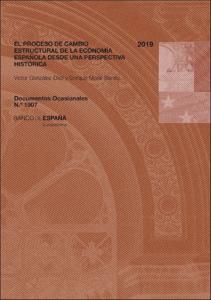El proceso de cambio estructural de la economía española desde una perspectiva histórica
Authors
Issue Date
17-May-2019
Physical description
34 p.
Abstract
La experiencia histórica y la literatura económica muestran que el proceso de cambio estructural de las economías hacia estadios avanzados de desarrollo sigue unas pautas de desarrollo sectorial. En una primera fase, aumenta la producción industrial y disminuye el peso de la agricultura en el producto de la economía. En una segunda fase, se produce una disminución relativa del sector industrial y aumenta de manera sostenida la aportación de la actividad en los servicios. Este trabajo presenta una breve panorámica de la evidencia empírica disponible sobre este proceso de transformación estructural a escala internacional, con especial énfasis en el caso de la economía española. Como resultado del rápido proceso de cambio estructural de las cuatro últimas décadas, la estructura productiva de la economía española ha convergido hacia la de los principales países europeos de referencia, con un mayor peso de los servicios y de las manufacturas, y un sector agrícola con una importancia reducida. Más allá del impacto de las fluctuaciones cíclicas, cabe esperar que continúen ganando peso en el futuro los sectores relacionados con los servicios, en detrimento de las manufacturas y de la agricultura. De acuerdo con la literatura, este sesgo hacia un aumento del peso de los servicios puede deberse a fuerzas de demanda (preferencias de los ciudadanos), de oferta (tendencias diferentes en las productividades sectoriales), o a una combinación de ambas a causa de la apertura al comercio internacional, que puede acelerar el proceso. Con todo esto, investigar en profundidad las causas del fenómeno de transformación estructural en el caso español resulta prioritario, puesto que el devenir futuro de dicho proceso determinará, en buena medida, el crecimiento económico a largo plazo de la economía española
The historical experience and the economic literature show that the process of structural change of the economies towards more advanced stages of development is associated to a particular pattern in the evolution of the sectorial composition of economic activity. In a first stage, the share in manufacturing increases while the share in agriculture decreases. In a second stage, the share in manufacturing starts decreasing, and the share in services starts increasing. This work presents a brief overview of the available empirical evidence about this process of structural change at international level, highlighting the case of the Spanish economy. As a result of the rapid process of structural change during the last four decades, the productive structure of the Spanish economy has converged towards that of the European countries, with higher shares in services and manufacturing, and a lower share in agriculture. Beyond the impact of cyclical fluctuations, we can expect increases in the services share at the expense of manufacturing and agriculture share. According to the literature, these patterns can be related with demand forces (citizen’s preferences), supply forces (different trends in sectorial productivity), or a combination of both due to the openness to international trade, which can accelerate the process. Therefore, a deep investigation of the causes of this phenomenon of structural change in the Spanish case is essential inasmuch the future development of the process will determine long-run economic growth
The historical experience and the economic literature show that the process of structural change of the economies towards more advanced stages of development is associated to a particular pattern in the evolution of the sectorial composition of economic activity. In a first stage, the share in manufacturing increases while the share in agriculture decreases. In a second stage, the share in manufacturing starts decreasing, and the share in services starts increasing. This work presents a brief overview of the available empirical evidence about this process of structural change at international level, highlighting the case of the Spanish economy. As a result of the rapid process of structural change during the last four decades, the productive structure of the Spanish economy has converged towards that of the European countries, with higher shares in services and manufacturing, and a lower share in agriculture. Beyond the impact of cyclical fluctuations, we can expect increases in the services share at the expense of manufacturing and agriculture share. According to the literature, these patterns can be related with demand forces (citizen’s preferences), supply forces (different trends in sectorial productivity), or a combination of both due to the openness to international trade, which can accelerate the process. Therefore, a deep investigation of the causes of this phenomenon of structural change in the Spanish case is essential inasmuch the future development of the process will determine long-run economic growth
Publish on
Documentos Ocasionales / Banco de España, 1907
Other versions
Subjects
Cambio estructural; Sectores económicos; Análisis sectorial; Economía española; Structural change; Economic sectors; Sectorial analysis; Spanish economy; Sistemas económicos; Evolución y desarrollo económicos; España
Appears in Collections:












